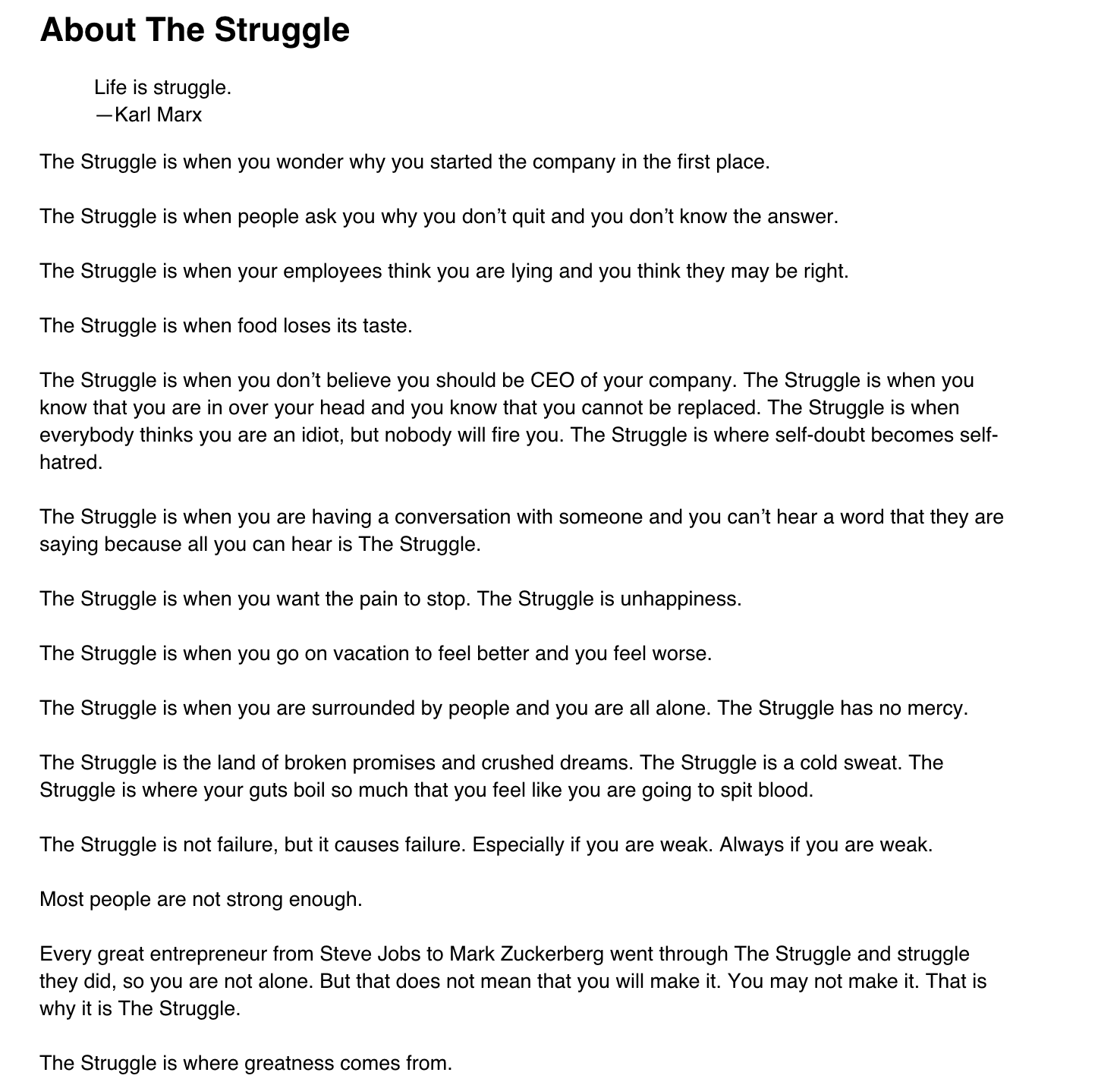October’s Editorial Theme: The Struggle
Sometimes it takes an overwhelming breakdown to have an undeniable breakthrough.

Steve Jobs got fired from the company he started.
Disney barely survived due to its founder’s poor budgeting habits.
J.K. Rowling, one of the richest women in the world today, once depended on welfare to survive.
And Tim Ferris, bestselling author of “The 4-Hour Work Week” was rejected 25 times before finding a publisher, who would work with him.
Even the most horrific Halloween stories have nothing on entrepreneurs’ sagas about “The Struggle.”
When you are in The Struggle, nothing is easy and nothing feels right. You have dropped into the abyss and you may never get out. – Ben Horowitz

This month’s theme centers around “The Struggle” and therefore, brave entrepreneurs.
When you really give a damn, you’re willing to fight for it. Tell us about how you fought through your struggle.
Just because you have a hoodie and 7-figure check from a VC… that doesn’t mean you will create the next big thing. It comes down to ambition; it’s something that’s in your veins.
Whether you’re currently going through “The Struggle,” or you have experienced this hell in the past, we want to publish your story of triumph and conflict.
Tell us, in grave detail, about a time when your startup or professional life took a horrifying turn for the worst, and if/how you overcame it.
We only want to hear true tales – either of your own struggle(s) or of someone you know or can interview.
I owe my smile to perserverance.
P.S. We will accept anonymous submissions because we know this can be a sensitive topic. Of course, we do believe that it takes guts to get out of the ruts so we hope you’ll own your struggle for what it was – a conflict that ultimately nourished your success.
Frequently Asked Questions about The Struggle Theme
What is the significance of the struggle theme in literature?
The struggle theme is a prevalent motif in literature, often used to depict the protagonist’s journey towards achieving a goal or overcoming a challenge. It serves as a mirror to real-life experiences, allowing readers to connect with the characters on a deeper level. The struggle can be internal, such as battling personal demons or external, like societal pressures or physical obstacles. This theme is significant as it highlights the resilience of the human spirit and the ability to triumph over adversity.
How does the struggle theme contribute to character development?
The struggle theme plays a crucial role in character development. It provides the characters with challenges that test their strength, resilience, and determination. As they navigate through these struggles, they grow and evolve, revealing their true character. This transformation not only makes the characters more relatable but also adds depth to the storyline.
Can you provide examples of the struggle theme in popular literature?
Certainly, the struggle theme is prevalent in many popular works of literature. For instance, in Ernest Hemingway’s “The Old Man and the Sea,” the protagonist struggles against nature to catch a giant marlin. Similarly, in Harper Lee’s “To Kill a Mockingbird,” the characters struggle against societal prejudices. These struggles not only drive the plot but also contribute to the overall message of the story.
How does the struggle theme relate to real-life experiences?
The struggle theme in literature often mirrors real-life experiences. It depicts the challenges and obstacles that individuals face in their daily lives. This theme resonates with readers as it reflects their own struggles, making the story more relatable and impactful.
How can the struggle theme be interpreted differently by different readers?
The interpretation of the struggle theme can vary among readers based on their personal experiences and perspectives. Some may view it as a testament to human resilience, while others may see it as a commentary on societal issues. This diversity in interpretation adds to the richness and depth of the theme.
How does the struggle theme influence the plot of a story?
The struggle theme often serves as the driving force behind the plot of a story. It sets the stage for conflict, tension, and resolution, thereby keeping the readers engaged. The protagonist’s struggle and their journey towards overcoming it forms the crux of the story, making it more compelling and engaging.
How can the struggle theme be used effectively in storytelling?
The struggle theme can be effectively used in storytelling by creating relatable characters, setting up believable challenges, and depicting realistic outcomes. It’s important to balance the struggle with moments of triumph to keep the readers invested in the story.
How does the struggle theme contribute to the emotional impact of a story?
The struggle theme contributes significantly to the emotional impact of a story. It elicits empathy from the readers as they witness the characters’ hardships and root for their success. This emotional connection enhances the overall reading experience.
Can the struggle theme be combined with other themes in literature?
Absolutely, the struggle theme can be combined with other themes such as love, friendship, betrayal, and redemption. This combination can add layers to the story, making it more complex and engaging.
How does the struggle theme reflect societal issues?
The struggle theme often reflects societal issues like discrimination, poverty, and injustice. It serves as a commentary on these issues, prompting readers to reflect on them and potentially inspiring change.
Lauren Holliday is a full-stack marketer.


